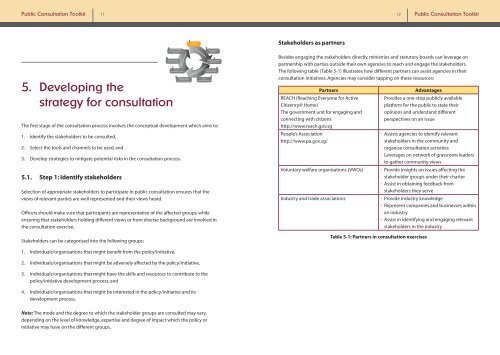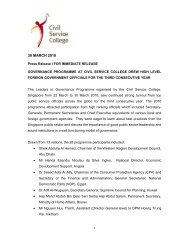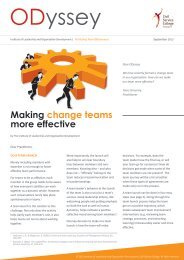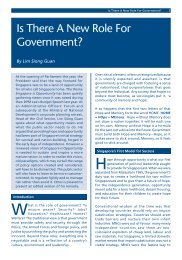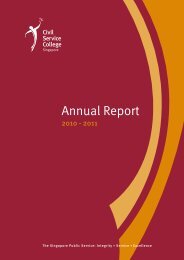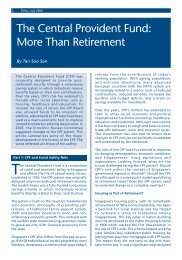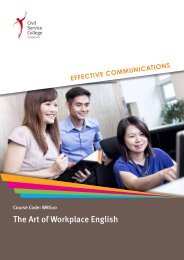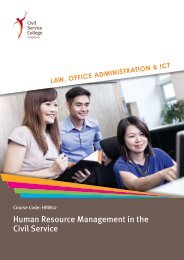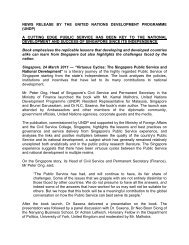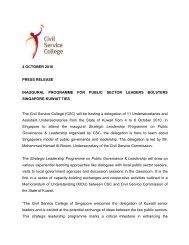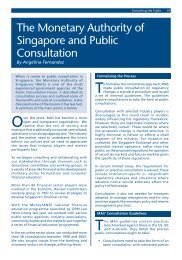Public Consultation Toolkit - Civil Service College
Public Consultation Toolkit - Civil Service College
Public Consultation Toolkit - Civil Service College
You also want an ePaper? Increase the reach of your titles
YUMPU automatically turns print PDFs into web optimized ePapers that Google loves.
<strong>Public</strong> <strong>Consultation</strong> <strong>Toolkit</strong> 11 12 <strong>Public</strong> <strong>Consultation</strong> <strong>Toolkit</strong><br />
Stakeholders as partners<br />
5. Developing the<br />
strategy for consultation<br />
The first stage of the consultation process involves the conceptual development which aims to:<br />
1. Identify the stakeholders to be consulted,<br />
2. Select the tools and channels to be used, and<br />
3. Develop strategies to mitigate potential risks in the consultation process.<br />
5.1. Step 1: Identify stakeholders<br />
Selection of appropriate stakeholders to participate in public consultation ensures that the<br />
views of relevant parties are well represented and their views heard.<br />
Officers should make sure that participants are representative of the affected groups, while<br />
ensuring that stakeholders holding different views or from diverse background are involved in<br />
the consultation exercise.<br />
Stakeholders can be categorised into the following groups:<br />
Besides engaging the stakeholders directly, ministries and statutory boards can leverage on<br />
partnership with parties outside their own agencies to reach and engage the stakeholders.<br />
The following table (Table 5-1) illustrates how different partners can assist agencies in their<br />
consultation initiatives. Agencies may consider tapping on these resources:<br />
Partners<br />
REACH (Reaching Everyone for Active<br />
Citizenry@ Home)<br />
The government unit for engaging and<br />
connecting with citizens<br />
http://www.reach.gov.sg<br />
People’s Association<br />
http://www.pa.gov.sg/<br />
Voluntary welfare organisations (VWOs)<br />
Industry and trade associations<br />
Advantages<br />
• Provides a one-stop publicly available<br />
platform for the public to state their<br />
opinions and understand different<br />
perspectives on an issue<br />
• Assists agencies to identify relevant<br />
stakeholders in the community and<br />
organise consultation activities<br />
• Leverages on network of grassroots leaders<br />
to gather community views<br />
• Provide insights on issues affecting the<br />
stakeholder groups under their charter<br />
• Assist in obtaining feedback from<br />
stakeholders they serve<br />
Table 5-1: Partners in consultation exercises<br />
• Provide industry knowledge<br />
• Represent companies and businesses within<br />
an industry<br />
• Assist in identifying and engaging relevant<br />
stakeholders in the industry<br />
1. Individuals/organisations that might benefit from the policy/initiative,<br />
2. Individuals/organisations that might be adversely affected by the policy/initiative,<br />
3. Individuals/organisations that might have the skills and resources to contribute to the<br />
policy/initiative development process; and<br />
4. Individuals/organisations that might be interested in the policy/initiative and its<br />
development process.<br />
Note: The mode and the degree to which the stakeholder groups are consulted may vary,<br />
depending on the level of knowledge, expertise and degree of impact which the policy or<br />
initiative may have on the different groups.


